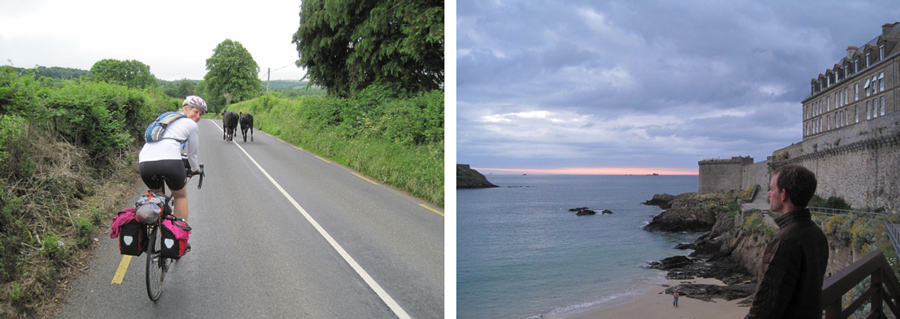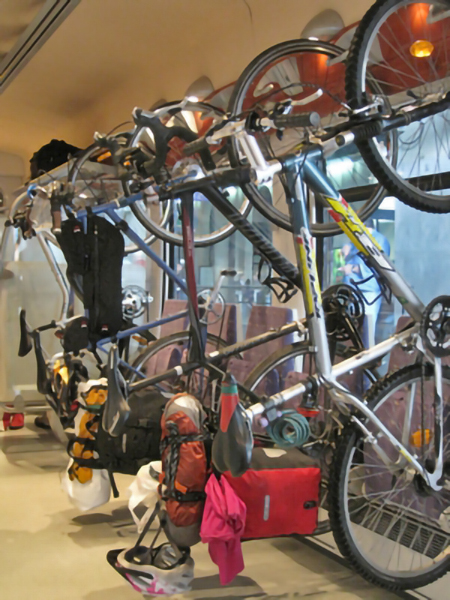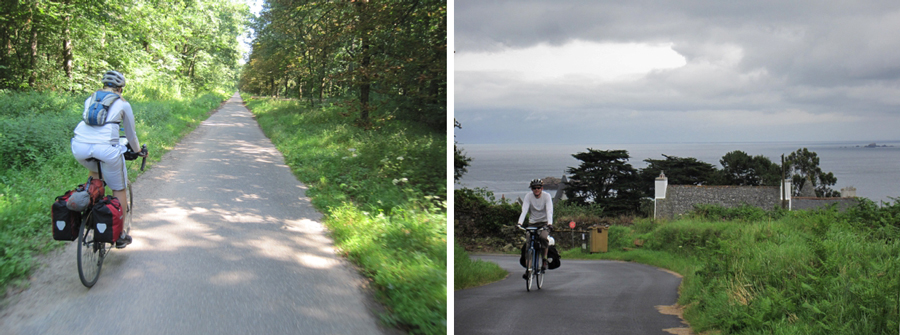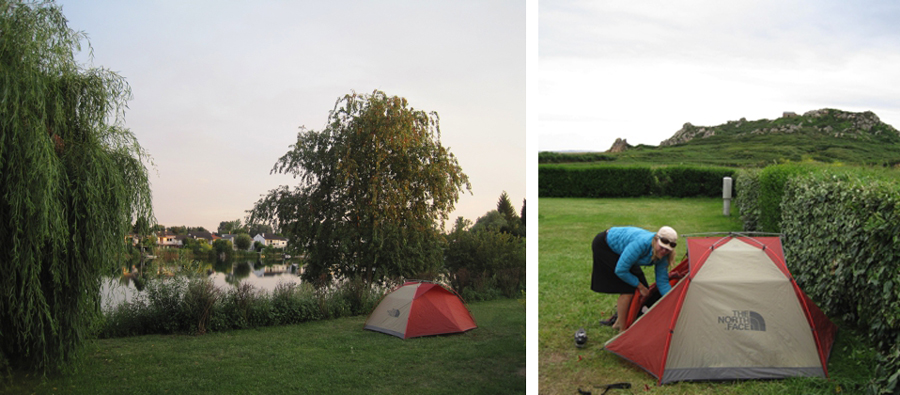Tour It Yourself: Cycling In Europe
Europe is the birthplace of the Tour de France, the rear derailer, the Dutch utility bike, and the trans-continental bike route. Nevertheless, it can be intimidating to plan your own bike tour there. How do you choose a route? Where do you stay? How much planning do you really need to do?
Despite these challenges, planning your own bike tour can reduce costs, allow flexibility for route changes, get you off the beaten path, and make you proud to be self-reliant. And although there isn’t a SAG wagon, you aren’t on a completely unsupported tour: Europe has a well-developed rail network, lots of campgrounds and bike shops, accurate maps, and delicious food in every town. And it is an excellent place to start touring on your own.
In the summer of 2012, starting with only a rough outline of our route, my wife and I went on a two-month honeymoon, riding our bikes through Ireland, France, Italy, Switzerland, and Germany. Here are a few of the things that we learned along the way about trip planning, touring, and maintaining matrimonial bliss.
Where To Go?
A map of Europe can be daunting. There are a lot of roads, and there’s a lot to see. If you don’t know where to start, I have two words for you: river valleys. Rhone, Rhine, Loire, Dordogne, Elbe, Danube: they’re all flat, have bike routes running along their rivers, contain historic cities, and continue for long distances. Another planning tool is to use national or trans-national bike routes. The Eurovelo system currently contains 14 routes that criss-cross the continent. The routes are at various stages of development so it would be best not to rely on them exclusively, and instead, use them as a tool to find classic and well-traveled routes.

When choosing where to go, consider when you’re going. For example, June was a wonderful time to visit northern France: the weather was almost perfect, other than the rain (an accurate postcard said “In Brittany, the weather is beautiful — several times a day”). Attractions like Mount Saint Michel were all but deserted. That changes mid-July through August as most of Europe goes on vacation. Although the Dordogne Valley is beautiful, scenic, and quaint, we did not particularly enjoy being there in July because there were just too many tourists packing the streets and markets of Sarlat and other nearby towns. And July was just too hot for bicycling in Italy.
If you are obliged to travel during July and August, you may want to pick somewhere that is less well-known (and cooler). An example is the southern Rhine in Germany. Although not as well-known as the “Romantic Rhine” further north, it had few tourists in August, miles of bike path through gorgeous forests, and lesser-known but very livable cities such as Karlsruhe that are great for café-sitting and people-watching.
Planes, Trains, Automobiles, and Boats
If you already have a bicycle, why pay to rent another one? Some airlines will allow bicycles to fly for free as long as they are under the maximum-allowed weight. To avoid paying any additional fees, we each packed our bike box to the British Airways limit of 51 pounds by stuffing a pannier, a garbage bag of clothes, and other soft items inside, and then we each used our other pannier as a carry-on.
Another advantage of flying with your bike is starting the tour at the airport. We reassembled our bikes in a quiet corner of the Dublin airport and then rode off to our first B&B. Like James Bond taking off his wetsuit to reveal a tuxedo underneath, it was a satisfying transition from plane passengers to bike tourists. At the end of our trip in Copenhagen, we paid a bike shop to pack up our bikes and deliver our boxed bikes to the airport terminal, which gave us more time to tour the city. We had mailed some of our bike packing materials — pipe insulation and dummy axles — ahead of us to a friend in Copenhagen, which turned out to be a good idea. They were lightweight and cheap to ship, and the Copenhagen bike store did not have them on hand.
To add an island or two to your trip itinerary, taking a ferry is the ticket. Ferry networks link Ireland and the UK with France and Spain, and criss-cross the Mediterranean. Many tourists from the UK head to the Continent for the summer, so beware — ferries across the English Channel become fully booked months in advance. They can also be a significant expense. We paid about $200 each to get from Cork, Ireland, to Roscoff, France. Shorter ferries such as the one from Puttgarden, Germany, to Rødby, Denmark, are much cheaper and usually do not require advance reservations.

We relied on Europe’s railways to visit a wider range of places than we could have by bicycle alone. Purchasing tickets ahead of time can reduce the price, but having to be at a particular train station on a particular day may add unnecessary stress to your trip. In France, Italy, Germany, and Switzerland, we never had a problem showing up at a train station and buying a ticket for the same day. Also, buying tickets from an agent at the station ensured we were always on a train that allowed bicycles and that we had a ticket for our bikes if necessary.
Most trains have a car designated for bicycles. Each country’s system is slightly different but the pattern is always the same: spot the designated bike car as the train arrives, make a dash for it, and get the bikes on board and stowed, possibly removing the panniers in the process. Having a bit of rope or a piece of nylon webbing with a buckle to help stabilize the bikes, and locking them together, gave us peace of mind if we couldn’t sit near them.
Navigation
To be your own guide means finding your own way, and this usually means having a good map. It also means learning about the scale numbers on map covers. We found the magic number to be 1:250,000. At the beginning of our trip in Ireland, we used a 1:350,000 map but found it to be not detailed enough. This made it unclear which roads were on the map — and marital discord ensued, kind of like on TV commercials. Fortunately for us, the Irish are very outgoing and treated an opened map like a flaming neon sign reading “Help us. We urgently need directions!” making it less of an issue than it might have been elsewhere.
We started out our trip assuming we would make decisions and navigate jointly as we went along. After a couple of days, we realized this arrangement wasn’t ideal: there is only one map; it takes effort to keep the route in mind; and each fork in the road shouldn’t be a navigation discussion.
In France Michelin’s 1:250,000 regional maps have just enough detail that there is never a question about which turn to take. The coding of roads is also very consistent. White roads are always fully paved and have low traffic. Yellow roads have annoying but not overwhelming amounts of traffic. One chevron means a fairly challenging hill. Two chevrons means a brutal hill. Three chevrons means “Welcome to the Alps.” A green border on one side means “scenic,” which Michelin doles out only to the most worthy road segments. Route planning in France is a matter of maximizing Michelin’s white and green roads and minimizing the number of chevrons and yellow roads.

A Swiss bike tour can be flatter than one might expect because many routes run along valleys. The Swiss national bike-route system is so organized and efficient that we didn’t even need a map, and instead followed signs the entire way. At every juncture where we started to doubt and thought, “Gosh, I sure hope we are still on the route,” suddenly another sign would appear pointing the way. Swiss tour operator SwissTrails has excellent English-language fact sheets on its website describing many of the national bike routes. These also include elevation profiles and lodging options in each town.
Germany also has an extensive network of bike paths. It would be possible to tour much of Germany without ever sharing pavement with cars, however, there are so many bike paths that navigating them can be somewhat complex. A signpost at a major German bike-path crossing might have a dozen signs, with some sporting logos for various regional, national, and Eurovelo routes that share that segment of bike path, and others with names of towns in all directions. Maps from the German National Bike Club, the ADFC, available online and in most German bookstores, put the trails in perspective showing bike paths, bike shops, campgrounds, and restaurants.

Two other helpful pieces of navigation equipment are a compass and a digital camera. A compass on your handlebars can help confirm you are heading a particular direction without having to stop. A digital camera can capture maps that you encounter, such as the tourist maps posted in many European towns or maps online. A picture of the latter is often quicker and cheaper than a printout, allowing you to carry along copies of sections of Google Maps or other online mapping tools.
Trip Leadership
We started out our trip assuming we would make decisions and navigate jointly as we went along. After a couple of days, we realized this arrangement wasn’t ideal: there is only one map; it takes effort to keep the route in mind; and each fork in the road shouldn’t be a navigation discussion. In addition, there were some tasks neither of us enjoyed, like calling around for a place to stay or buying train tickets, and it was tiresome to decide who was going to do those tasks each time.
My wife is a whitewater rafting guide, and we borrowed the term “TL” (for “trip leader”) from the rafting world. We traded off for two days at a time in that role. The TL planned the route for the day, gave a briefing to the other person on expected distance and any hills en route, and planned where we would stay, making calls for a hotel reservation if necessary. This worked very well for us. Being TL provided each of us with a sense of control and the opportunity to learn about the geography of the region, while the days off allowed us to enjoy the scenery and be in “vacation mode.” For other couples or groups, it may make sense to allocate leadership differently, but in a trip without a paid tour guide, it can be helpful to discuss the process for navigation and decision making ahead of time.
Camping Out
Europeans love to camp. This is nowhere more evident than in France, where town governments seem to regard a municipal campground as an infrastructure item only slightly less important than a school or church. Germany, Switzerland, and Italy also have a decent number of campgrounds, albeit more concentrated near tourist areas. For the DIY bike tourist, this means cheap places to sleep and take hot showers which don’t require reservations.
Most campgrounds are designed primarily for camping vehicles, so there is almost always room for a tent and a couple of bicycles. In peak season in highly-touristed areas, you should nevertheless be prepared to be packed in a sardine-like manner next to your neighbors. In the offseason or in less-touristed areas, it is often possible to stay in a mostly empty campground. And although many campgrounds are little more than a plain field at the edge of town, some are spectacular. In Primel-Trégastel, Brittany, we stayed in a mostly empty campground that was about 20 feet from a spectacular shoreline. In Germany, we stayed in a spacious field next to the North Sea.

Finding maps and printed references for campground locations can be a challenge. The France association Camping Qualité mailed us a free map of all of their associated campgrounds, which showed us how many campgrounds were located in various regions. In Germany, we used the ADFC cycling map to find campground locations. It was a bit more challenging in Italy, where campsites are mostly located in touristed areas and are often very large complexes.
In Switzerland the SwissTrails fact sheets provide campsite information, and “Sleep in the Straw,” or Schlaf im Stroh is an association of farmers with haylofts where tourists can sleep for about the same price as camping.
Cool Camping lists particularly scenic campsites in France and the UK on its website and in its guidebooks. Camping on parkland or farmland is also an option. We tried it once in Ireland and I have also done it on several other occasions in France, staying in parks where camping is technically not permitted but the restriction is not enforced.
Another option is to ask a farmer for use of their land, however, the downside to these options is the lack of a hot shower at the end of the day when you are sweaty and covered in sunscreen.
To Cook Or Not To Cook?
Camping often goes with camp cooking, but that doesn’t have to be the case in Europe. The French require a baguette or chocolate croissant to start the day, the Germans need their brötchen, and most campsites cater to these needs. Campgrounds often will take orders for baked goods in the evening for delivery the next morning and every town and many campgrounds have a café for a hot drink.
When we planned our trip, we debated bringing a camp stove but never regretted having left it at home. But we didn’t eat in restaurants and cafés for every meal. Europe has a delicious array of cheeses, meats, fresh-baked breads, and fresh produce that can be purchased in grocery stores or at local outdoor markets. For lunch most of the time, we made sandwiches out of a baguette, tomato, soft cheese, and hard salami, and topped them with sauces like pesto or olive tapenade.
While trip-planning, ensure you have enough free space to carry extra food with you. We found that nothing killed the honeymoon spirit as quickly as an underfed spouse. Even for those going fast and light, a day will come when lunchtime arrives and the nearest café, grocery, or market is an hour or two away.

Mechanical Issues
If you can patch a flat, repair a chain, replace a brake or derailer cable, adjust your brakes, and perhaps also true a wheel, you can fix most of the problems that come up on the road. Although there are many things that can go wrong with a bicycle, the remainder are either uncommon or wouldn’t prevent you from riding to the next bicycle shop. If you are mechanically disinclined, an upcoming DIY tour might be the time to sign up for a class to learn essential repairs. Having your bike checked out by a shop ahead of time can also reduce the odds of something going wrong while on tour.
One special mechanical note about Germany is that, while bike paths are everywhere, the material and quality of the paths is variable. Gravel and pavement are marked identically on the ADFC maps, and curbs and tree-root bumps are common and can cause pinch-flats. The Germans adapt to this with fatter tires (35mm or more), which might be wise for a lengthy tour there. Ensuring that you have a pump that reaches high pressure (7 bar/100 PSI) also helps to prevent pinch-flats. If you inflate your tires at bike shops, use a standing hand pump to reach full pressure rather than a hose from an air compressor which often only reach about 5 bar.
Information Technology
If you are only gone for a week or two, and deliberately want to get away from it all, then it may make sense to leave all electronics at home. Your friends can hear about the trip when you return. If you need to phone home a couple of times, internet cafés are ubiquitous and with services like Skype or Google Voice, you can call most numbers for a few cents a minute. Many hotels and campgrounds provide wireless internet so carrying a smartphone can be helpful for the same reason, even if the cell service is turned off.
Another alternative is to get a prepaid phone in Europe. For €30 or so, this is perhaps the simplest and most reliable way to be able to call numbers within Europe, but without a separate calling card, it will be expensive to call elsewhere. Ebook readers are also a great way to bring along guidebooks, reading material, and other documents without adding much weight. Devices using e-ink instead of an LCD display can last a week or longer without a recharge. Even my wife, an entrenched Luddite, was won over by her ebook reader during our trip.
Adventure Awaits
Being our own tour planners was more effort but it was also well worth it. Researching the trip ahead of time added to the anticipation and helped us learn more about the places we considered going. On the road, we knew we had the essentials with us and that the rest would be available along the way. Each day, we’d wake up, pick a spot on the map, and pedal towards it. In the end, it was an adventure that we were proud to have arranged ourselves.
Additional Information:
Language
If you studied a European language in high school for a few years and can barely get out a “Guten Tag” or “Comment-allez vous,” then you might view planning a bike trip around Europe as an opportunity to practice. But even if you don’t speak a lick of anything other than English, you can still get by pretty easily. In countries such as Germany, Switzerland, the Netherlands, Denmark, and Belgium, a large part of the population can easily speak conversational English. France is a bit more challenging, although many workers in the hospitality professions and younger people will still speak at least passable English. We found Italy to be the most difficult, with fewer people who speak any languages other than Italian. Almost everywhere, though, hotel staff and other tourism workers were very likely to speak English. Where all else fails, pointing and other hand gestures can go a surprisingly long way.
Security
Bike theft is as much of a problem in Europe as anywhere else, and there is a balancing act between security and reducing weight. When calling ahead to hotels, ask if they have indoor storage for bicycles — almost all do. We brought a mid-weight cable lock, which worked well, although we also never strayed far from our bikes. Another factor is what bike you bring, which I didn’t fully consider ahead of time. Whereas my wife brought a serviceable midrange bike, I brought a beloved custom-made bicycle. While I (possibly) had a better ride during the day, I worried more at night. In campgrounds, other European bike tourists seemed more lax about locking their bicycles up, either using a lightweight lock or a built-in wheel lock. We locked our bikes to a tree if our campsite had one. In a few urban campsites where we felt more paranoid, we tied bells to the bikes and also tied them to our tent with fishing line so that we would be alerted if anyone tried to move them.
Packing Up
What to pack in your panniers is very much a matter of taste but there are a couple of things that can help prevent regrets on the road (or trips to the post office to ship things home). The first is to test-pack: get everything you are going to bring inside your panniers or frame bags and make sure you still have room for food and other on-the-road purchases. The second is to weigh each item and make a spreadsheet as you unpack from the test-pack.
This second point might sound a little obsessive-compulsive, but it helped us sort through the items we were going to carry around for months — it’s much easier to hit “sort” (by item weight) on the spreadsheet than to physically sort items on the living room floor, and you may be surprised at what items weigh the most.
For example, maps are surprisingly heavy if you are bringing more than a few and they can often be purchased en route. On the other hand, extra pairs of socks may be worth 30 grams each to ensure your feet are always clean and dry. Although we thought we might end up with a total of six or eight panniers, we ended up with just four — two each — for a total of about 40 pounds. At no point on the trip did we feel like we had left something important at home. Another advantage of the spreadsheet packing list was to ensure that we had everything on the final pack.
In particular, we were happy to have resisted the temptation to bring excessive camping gear. A tent and a sleeping bag were really all we needed. As a couple, the camping item that made us happiest was a double sleeping bag. On the other hand, we almost never used the camp chairs we brought along: if we needed to sit, there was usually a café nearby.

